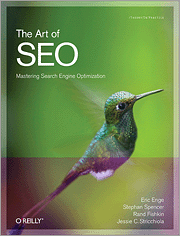 I tripped over SEO last night. O’Reilly Media sent me a copy of their latest SEO book “The Art of SEO,” which I had peer reviewed a couple of months ago. I was pleasantly surprised to find it waiting for me on my doorstep when I got home from work, though my toes were less pleased.
I tripped over SEO last night. O’Reilly Media sent me a copy of their latest SEO book “The Art of SEO,” which I had peer reviewed a couple of months ago. I was pleasantly surprised to find it waiting for me on my doorstep when I got home from work, though my toes were less pleased.
Reviewing the “The Art of SEO” in-progress was an interesting and humbling experience, especially with four well known SEOs tackling the authorship jointly:
- Eric Enge: President of Stone Temple Consulting in Boston
- Stephan Spencer: President & Founder of Netconcepts in Madison
- Rand Fishkin: CEO & Co-Founder of SEOmoz in Seattle
- Jessie Stricchiola: Founder of Alchemist Media in San Francisco
The result is a collection of the best practices in search engine optimization from soup to nuts. Or rather from 301s to web spam.
The first two chapters focus set the stage with general level setting on what SEO is, how it differs from other forms of marketing, and how search engines work. For SEO newbies, this is a valuable introduction to understand how to talk the talk. More experienced folks may pick up a nugget or two on the ins and outs of the algorithms but for the most part it’s a refresher.
The goal setting, planning and measurement chapters (3, 4 & 9) should be required reading. Creating an SEO program isn’t just deciding to update a few title tags. Brainstorming a list of 100 keywords to target does not constitute planning. SEO professionals must know what to analyze and benchmark to set realistic goals, determine where time spent is most likely to produce a positive ROI, and collecting the data for measuring progress down the road. Read. These. Chapters.
Chapter 5 covers the basics of keyword research, one of the cornerstones of all SEO decision making. I would hope that everyone has their keyword research data (yes, actual numerical data) stapled to their foreheads before touching their sites …. On second thought, add chapter 5 to the required reading list with 3, 4 & 9.
Chapter 6 & 10 are probably my favorites, because they focus on the structural, technical and architectural aspects of SEO. The down-and-dirty geeky stuff. These chapters cover crawl paths, subdomains, URLs, duplicate content, content delivery, redirects, robots, geotargeting, redesigns, spamming methods (to avoid) and other juicy topics. It’s just not possible to cover all the intricacies in two chapters, all the issues and decisions that real businesses run into every day managing their sites, but this is a great introduction at a 1,000-foot level.
Chapter 7 covers linking in more detail from both the engines’ algorithmic perspectives and the marketing perspective. How do you get more links? Are all links equal? What about buying links? How can you get more inks to be popular when you aren’t popular enough to get links? All good questions. Read chapter 7.
Vertical search is covered in Chapter 8 — local search, mobile, video, shopping, image, news, etc. Each of these has its own SEO peculiarities to consider.
Chapter 11 essentially provides a guide to continuing education. It’s hard to know whose SEO knowledge to trust. This chapter outlines some ways to educate yourself through competitive research and how to sniff out the reputable sources of information.
Chapter 12 is a doozy — the perennial question of in-house or agency. Both have their pros and cons, which are debated well here. The authors also cover hiring, choosing a reputable SEO agency, and working with mixed models.
The last chapter is the obligatory “The Future Of…” chapter. I was prepared to be bored, frankly. As conclusions go, this one was well written and actually insightful on the future of search engines, their algorithmic potential and the ways in which the SEO industry will need to evolve to remain relevant.
Bottom line: I think what I liked best about this book is the variety of perspectives. Four authors means four different ways of describing the SEO universe. I can’t say that it completely changed my world, but I wouldn’t be a very good SEO consultant if I hadn’t already been pretty intimate with these concepts. I did walk away from this review with some new perspectives, new ways to think about the same old issues, new data sources to analyze and new ways to analyze the same old data sources. That’s what I love about SEO: Every day you learn something new, every day your experience evolves as you expose yourself to new clients, new data, new theories. Everyone, even old dogs, can learn some new tricks. If you’re new to SEO and looking for a primer that covers the gamut, this book will serve you well. Give it a read.
Disclosure: I work at Netconcepts, Stephan Spencer’s SEO firm, as Director of Search Consulting Services. I was advising O’Reilly Media on their SEO when the book was going through review. Despite my double tie to the book, the opinions expressed here are specifically my own.

Originally posted on Web PieRat.


This looks like an interesting read. I guess you can never stop learning about SEO as technology and trends are changing all the time. Every time Google updates their algo, everyone takes a deep breathe. What I’ve found though is that if you give Google what it wants (essentially well optimized pages with great content) you should be ok.
Will definitely pick this up though and see if I can learn anything new.
Thanks in advance
Bill
It seems that everybody is recommending this book. My SEO friend recommended this book as well. So last week, I had placed an order from Amazon for $27. I just cant wait for it to come.